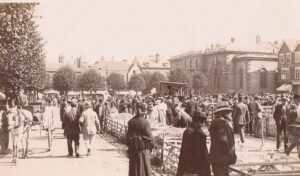
We are delighted to reproduce the following article which we believe is from the 1920s.
Unfortunately, the original publication is unknown as it was cut out of an old newspaper and inserted in a scrap album. However, it paints a wonderful picture of the old Salisbury Market Place and we hope you enjoy it.
The famous novelist, Charles Dickens, was very familiar with Salisbury – “the fair old city” as he described it, and the most vivid pen picture is to be found in one of his books, “Martin Chuzzlewit.”
Readers of that delightful volume will remember how Tom Pinch proceeded to the city in Pecksniff’s gig from the Wiltshire village where that worthy lived to meet Martin Chuzzlewit, and return with him. Martin was to take up residence with Pecksniff to be trained as an architect with that noted individual. Whilst he was at Salisbury waiting for Martin’s arrival from London with the coach, Tom Pinch, who was a quaint and original character, strolled through the streets and was particularly interested in the Market Place, and as it was market day he saw the place at its best.
“It was filled with carts, horses, donkeys, baskets, wagons, garden stuff, meat, tripe, pies, poultry and ruckster’s wares of every opposite description and possible variety of character,” we read. “Then there were young farmers and old farmers,” it was further recorded, “with smock frocks, brown greatcoats, drab greatcoats, red worsted comforters, leather leggings, wonderful shaped hats, hunting whips, and rough sticks, standing in groups, or talking noisily together on the tavern steps, or paying and receiving huge amounts of greasy wealth, with the assistance of such bulky pocket books that when they were in their pockets it was apoplexy to get them out, and when they were out it was spasms to get them in again.”
Truly a graphic description in the best Dickensian style. But what a difference from the scene at the Market Place today!
Then, we are further told: “Also there were farmers’ wives in beaver bonnets and red cloaks, riding shaggy horses purged of all earthly passions, who went soberly into all manner of places without desiring to know why, and who, if required, would have stood stock still in a china shop, with a complete dinner service at each hoof. Also, a great many dogs which were interested in the state of the market and the bargains of their masters; and a great confusion of tongues, both brute and human.” It must be a long time since a donkey was to be seen at the Market Place, and the number of dogs is limited. And as for farmers with smock frocks and their wives in fancy beaver bonnets, they have gone forever!
Tom Pinch, we are told, “regarded everything exposed for sale with great delight, and was particularly struck by the itinerant cutlery, which he considered of the very keenest kind, insomuch that he purchased a pocket knife with seven blades in it, and not a cut (as he afterwards found out) among them.” Poor old Tom Pinch, he was not the first to buy a pocket knife with not a cut in all the blades it contained. It is not an unusual occurrence!
Farmers in smock frocks were to be seen in the Salisbury Market place as comparatively recently as fifty years ago, so an old inhabitant assured me. It was a rather picturesque looking attire. There is a very good specimen to be seen in the Salisbury Museum.
Farmers who come to Salisbury Market to-day have still a partiality for leather leggings, as in Dickens’ day, but they do not carry “hunting whips and rough sticks,” and the bowler, or the trilby, has long since replaced the “wonderful shaped hat.”
But, despite the many changes that emanate from the whirligig of time the Salisbury Market Place, like Tennyson’s brook, goes on forever!